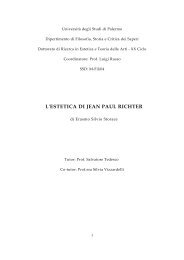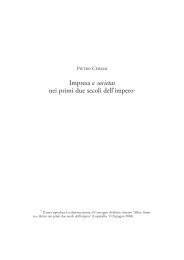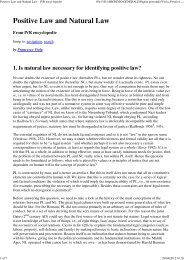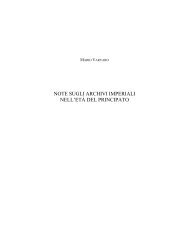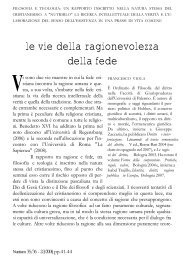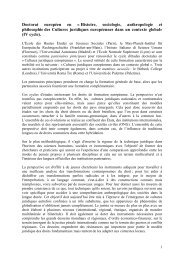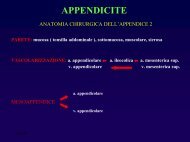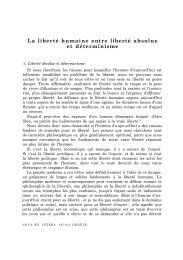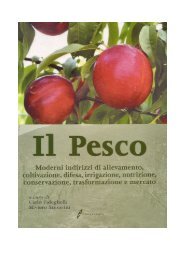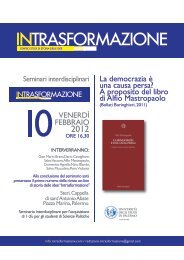M. VARVARO, Gai 4.163 e la struttura della formula arbitraria nell ...
M. VARVARO, Gai 4.163 e la struttura della formula arbitraria nell ...
M. VARVARO, Gai 4.163 e la struttura della formula arbitraria nell ...
You also want an ePaper? Increase the reach of your titles
YUMPU automatically turns print PDFs into web optimized ePapers that Google loves.
M. Varvaro, <strong>Gai</strong> <strong>4.163</strong> e <strong>la</strong> <strong>struttura</strong> del<strong>la</strong> formu<strong>la</strong> <strong>arbitraria</strong> [p. 705-734]<br />
2. Secondo Lenel in età adrianea il programma di giudizio del<strong>la</strong><br />
formu<strong>la</strong> <strong>arbitraria</strong> doveva essere concepito, con riferimento all’interdetto<br />
Quod ui aut c<strong>la</strong>m, nei seguenti termini:<br />
Quod opus ... ui aut c<strong>la</strong>m factum est, si arbitratu iudicis non restituetur,<br />
quanti ea res erit, et rel. 21<br />
Come si può notare, questa conceptio uerborum si apre con una<br />
c<strong>la</strong>uso<strong>la</strong> costruita come una demonstratio, 22 seguìta da una c<strong>la</strong>uso<strong>la</strong><br />
restitutoria (‘si ... non restituetur ’), cui si riconnette direttamente <strong>la</strong><br />
condemnatio al quanti ea res erit, in quanto quel<strong>la</strong> al quanti ea res est<br />
attestata in <strong>Gai</strong> <strong>4.163</strong> sarebbe «impensabile». 23<br />
——————————<br />
processo formu<strong>la</strong>re l’actio ex sponsione tertiae partis si faceva valere con <strong>la</strong> formu<strong>la</strong> di una<br />
condictio certae pecuniae, che era l’erede del<strong>la</strong> legis actio per condictionem ex lege Silia. Ciò<br />
risulta con sicurezza dal<strong>la</strong> prima delle due formule tramandate in TPSulp. 31 (= TP. 34),<br />
cui è anteposta una praescriptio ‘EA RES AGETVR DE SPONSIONE’, sul<strong>la</strong> quale v. ora F. LA<br />
ROSA, Brevi note esegetiche, in IVRA, 60, 2012, 125-127, <strong>la</strong> quale tenta di rinverdire <strong>la</strong><br />
tesi a suo tempo sostenuta da Sturm, secondo cui <strong>la</strong> praescriptio in questione sarebbe «una<br />
semplice étiquette de dossier», con un’argomentazione che dimentica però <strong>la</strong> chiara<br />
testimonianza di <strong>Gai</strong> 4.137 (che attesta una funzione ‘mista’ del<strong>la</strong> praescriptio, limitativa e<br />
determinativa insieme) e non tiene conto, a tacer d’altro, delle osservazioni formu<strong>la</strong>te in<br />
M. <strong>VARVARO</strong>, Praescriptio e pregiudizio, in IAH 2, 2010, 178-182. Sulle analogie e sulle<br />
differenze fra <strong>la</strong> sponsio e <strong>la</strong> restipu<strong>la</strong>tio (che avevano carattere penale, ma non<br />
pregiudiziale) cui si ricorreva quando si agiva con actio certae creditae pecuniae e quelle<br />
dell’agere ex interdicto cum periculo (che avevano carattere penale e pregiudiziale insieme),<br />
v. M. <strong>VARVARO</strong>, Praescriptio e sponsio nel<strong>la</strong> Tabu<strong>la</strong> Pompeiana Sulpiciorum 31, in<br />
AUPA 47, 2002, 396-403, con letteratura, cui adde K.A. SCHMIDT, Das<br />
Interdiktenverfahren, cit. (nt. 3), 252 s.<br />
21 O. LENEL, EP 3 , cit. (nt. 3), 449. In questo senso v. già le prime due edizioni: Das<br />
Edictum Perpetuum. Ein Versuch zu dessen Wiederherstellung, Leipzig 1883, 359; Das<br />
Edictum Perpetuum. Ein Versuch zu seiner Wiederherstellung 2 , Leipzig 1907, 433.<br />
22 O. LENEL, EP 3 , cit. (nt. 3), 449, in effetti, par<strong>la</strong>va al riguardo di una c<strong>la</strong>uso<strong>la</strong> che<br />
poteva essere intesa tanto come una proposizione iniziale simile a una demonstratio («demonstrationsähnlicher<br />
Anfangssatz»), quanto come una vera e propria demonstratio.<br />
23 Così O. LENEL, EP 3 , cit. (nt. 3), 447, nt. 2, secondo il quale sarebbe da credere<br />
inoltre che nel caso di interdetti per <strong>la</strong> protezione di luoghi sacri e religiosi <strong>la</strong> formu<strong>la</strong><br />
avesse una condemnatio in bonum et aequum concepta. Generalmente quanti seguono <strong>la</strong><br />
ricostruzione del modello formu<strong>la</strong>re suggerita da Lenel ne accettano anche, senza<br />
discuter<strong>la</strong>, <strong>la</strong> formu<strong>la</strong>zione del<strong>la</strong> condemnatio al QVANTI EA RES ERIT : v., per esempio, G.<br />
PROVERA, Il principio del contraddittorio nel processo civile romano, Torino 1968, 148; G.<br />
PUGLIESE, Istituzioni 3 , cit. (nt. 3), 337. So<strong>la</strong>mente pochi autori, prestando fede al chiaro<br />
dettato di <strong>Gai</strong> <strong>4.163</strong>, hanno preferito continuare a pensare che <strong>la</strong> condemnatio fosse al<br />
714 AUPA 55/2012



